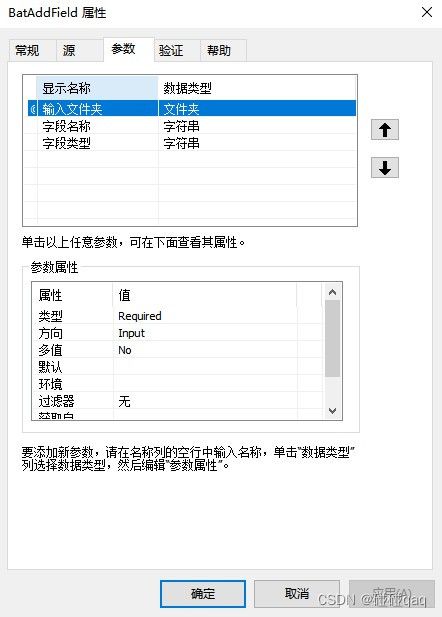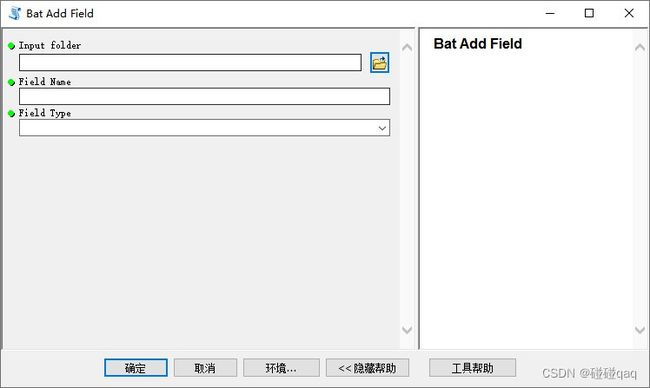ArcPy(1):比较自定义工具箱和Python工具箱创建地理处理工具
0 版本
- ArcGIS:10.6
- python:2.7.14
1 两种工具箱对比
注:以下内容总结自Esri官网
自 ArcGIS 10.1 起,使用 Python 创建自定义地理处理工具的方式有以下两种:自定义工具箱中的脚本工具和 Python 工具箱中的脚本工具。二者异同:
| 自定义工具箱 | Python 工具箱 | |
| 组织方式 |
|
|
优缺点:自定义工具箱各部分都是分离的,而且很难进行集中管理;而在Python工具箱中,参数定义、代码验证和源代码都在同一位置进行处理,因而Python工具的创建和维护更加容易。
2 创建自定义地理处理工具
注:按照上表中的步骤,以“为文件夹内shp文件批量添加字段”这一功能为例说明,代码中的具体函数不做进一步说明
2.1 使用自定义工具箱
2.1.1 编写批量添加字段代码
from imp import reload
import arcpy
# import os
# from os import path
import sys
import traceback
reload(sys)
sys.setdefaultencoding('utf8')
inFCDir = arcpy.GetParameterAsText(0)
fieldName = arcpy.GetParameterAsText(1)
fieldType = arcpy.GetParameterAsText(2)
arcpy.env.workspace = inFCDir
try:
fileList = arcpy.ListFiles("*.shp")
for file in fileList:
arcpy.AddField_management(file, fieldName, fieldType)
arcpy.AddMessage("{0} successfully".format(file))
printSuccess() #封装方法:打印成功提示信息
except arcpy.ExecuteError:
printArcPyException() #封装方法:打印arcpy异常信息
except:
printException() #封装方法:打印python异常信息2.1.2 通过向导定义的工具和参数定义
- 在“ArcGIS->我的工具箱->右键->新建工具箱”创建自定义工具箱;
- 在“自定义工具箱->右键->添加脚本”创建自定义地理处理工具,并设置上步的源文件及参数定义(工具参数定义需对应源码中arcpy.GetParameterAsText创建的参数),如下图所示;
2.2 使用Python工具箱
2.2.1 新建Python工具箱
在“ArcGIS->我的工具箱->右键->新建Python工具箱”创建Python工具箱;
2.2.2 Python工具箱模板
创建新 Python 工具箱时,工具箱创建为名为 Toolbox 的类。在 Toolbox 类的 __init__ 方法中已定义工具箱的属性,其中包括 alias、label 和 description。工具箱的名称由 .pyt 文件的名称定义。必须将 tools 属性设置为包含工具箱中定义的所有工具类的列表。本例中,创建一个名为 BatAddField 的工具。直接上代码,哈哈。
import arcpy
class Toolbox(object):
def __init__(self):
"""Define the toolbox (the name of the toolbox is the name of the
.pyt file)."""
self.label = "pptools"
self.alias = "pp arcpy tools"
# List of tool classes associated with this toolbox
self.tools = [BatAddField]
class BatAddField(object):
def __init__(self):
"""Define the tool (tool name is the name of the class)."""
self.label = "Bat Add Field"
self.description = ""
self.canRunInBackground = False
def getParameterInfo(self):
"""Define parameter definitions """
param0 = arcpy.Parameter(displayName="Input folder",
name="in_dir",
datatype="DEFolder",
parameterType="Required",
direction="Input")
param1 = arcpy.Parameter(displayName="Field Name",
name="field_name",
datatype="GPString",
parameterType="Required",
direction="Input")
param2 = arcpy.Parameter(displayName="Field Type",
name="field_type",
datatype="GPString",
parameterType="Required",
direction="Input")
param2.filter.type = "ValueList"
param2.filter.list = [
'Short', 'Long', 'Float', 'Single', 'Double', 'Text', 'Date'
]
params = [param0, param1, param2]
return params
def isLicensed(self):
"""Set whether tool is licensed to execute."""
return True
def updateParameters(self, parameters):
"""Modify the values and properties of parameters before internal
validation is performed. This method is called whenever a parameter
has been changed."""
return
def updateMessages(self, parameters):
"""Modify the messages created by internal validation for each tool
parameter. This method is called after internal validation."""
return
def execute(self, parameters, messages):
"""The source code of the tool."""
arcpy.env.workspace = parameters[0].valueAsText
fieldName = parameters[1].valueAsText
fieldType = parameters[2].valueAsText
try:
fileList = arcpy.ListFiles("*.shp")
for file in fileList:
arcpy.AddField_management(file, fieldName, fieldType)
arcpy.AddMessage("{0} successfully".format(file))
#addField(fileList, fieldName, fieldType)
printSuccess(messages)
except arcpy.ExecuteError:
printArcPyException(messages)
except:
printException(messages)
return
函数说明:
-
getParameterInfo(self):用于定义工具参数;
-
isLicensed(self):工具是否可用;
-
updateParameters(self, parameters):当更改参数值时候触发
-
updateMessages(self, parameters):This method is called after internal validation.
-
execute(self, parameters, messages):执行工具
3 最终工具展示
最终两种工具展示的结果是一样的,但是python工具箱的参数定义、代码验证和源代码都在同一位置进行处理,所以更易于维护。


